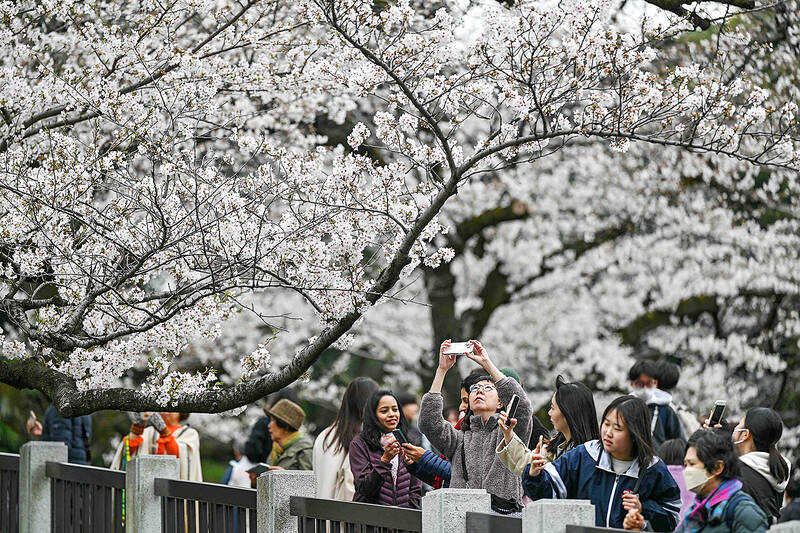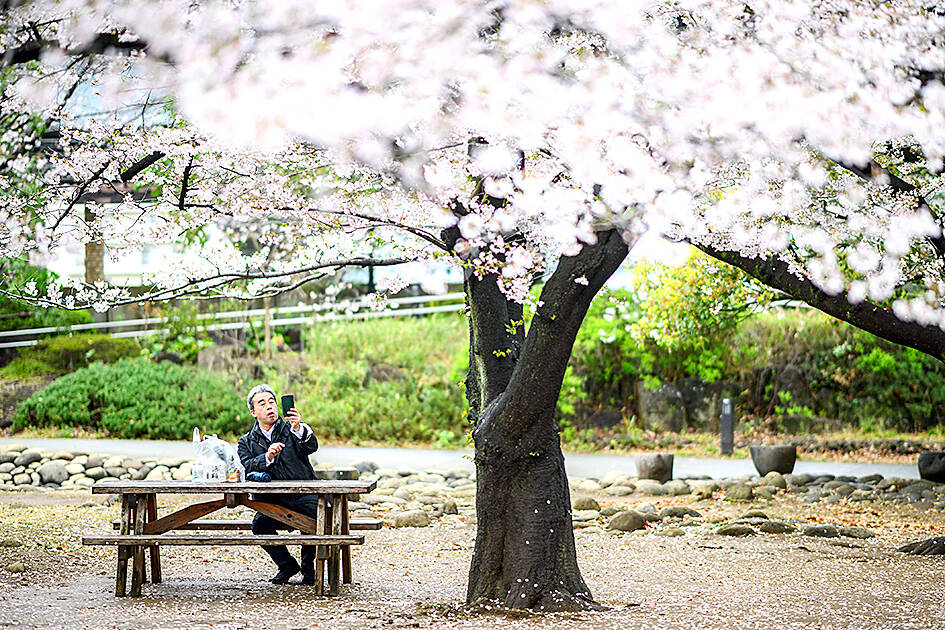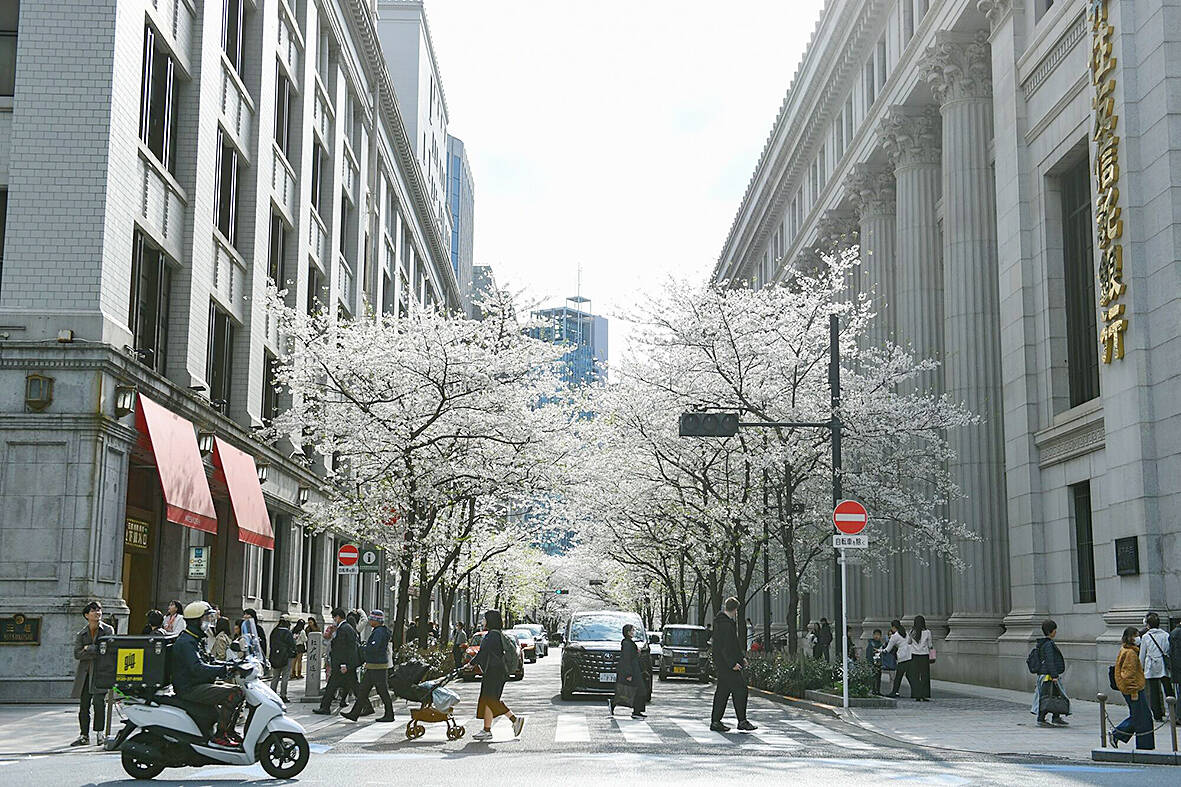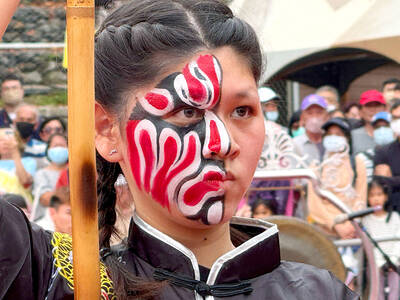Japan’s famed cherry trees are getting old, but a new AI tool that assesses photos of the delicate pink and white flowers could help preserve them for future generations.
The “sakura” season is feverishly anticipated by locals and visitors alike, with the profusion of the stunning blossoms marking the start of spring.
But many of the trees are reaching 70 to 80 years old, well beyond their prime blooming age.

Photo: AFP
This means increasing costs to tend to the trees and maintain popular flowering spots. To help authorities identify ailing specimens, brewing giant Kirin developed a tool called Sakura AI Camera.
It tells users the condition and the age of the trees based on photos they take with their smartphones and upload them to a Web site.
A five-point scale — only available in Japanese for now — ranges from “very healthy” to “worrying.”

Photo: AFP
A tree with healthy flowers blooming densely all the way to the tips of the branches gets top marks.
The artificial intelligence tool has been trained using 5,000 images of cherry trees with the help of experts.
The photos are then mapped on the Sakura AI Camera Web site with details such as tree condition and location.

Photo: AFP
“We heard that the preservation of sakura requires manpower and money and that it’s difficult to gather information,” said Risa Shioda from Kirin.
“I think we can contribute by making it easier to plan for conservation,” she said.
About 20,000 photos have been collected since the launch last month, with the data available online for free for local authorities.

Photo: Bloomberg
WORTH A MILLION
According to Tokyo’s Meguro Ward, famous for its riverbanks lined with cherry trees, replanting a new one costs around one million yen (US$6,800). Hiroyuki Wada of the Japan Tree Doctors Association, who inspects cherry trees in major spots in Tokyo, helped supervise the AI tool.
He said he hopes that it will help experts study the environmental reasons behind the degradation of some of the trees he sees.
In part, he blames climate change. “I’m very worried. Changes in the environment are usually gradual, but now it’s visible,” he said.
“There are impacts from the heat, and of course the lack of rainfall,” he said.
“The age of the trees naturally makes the situation more serious,” he added.
Japan’s weather agency said in January that last year was the hottest since records began, like other nations.
Kirin began donating some of its profits for the preservation of cherry trees last year, as a way to “pay back” to the communities.
Alcohol, especially beer, is one of the drinks enjoyed at hanami flower-viewing parties beneath the trees, Shioda said.
Cherry blossoms symbolise the fragility of life in Japanese culture as full blooms only last about a week before the petals start falling off trees.
The season is also considered one of change as it marks the start of the new business year, with many university graduates starting their first full-time jobs and older colleagues shifting to new positions.

The People’s Republic of China (PRC) last week offered us a glimpse of the violence it plans against Taiwan, with two days of blockade drills conducted around the nation and live-fire exercises not far away in the East China Sea. The PRC said it had practiced hitting “simulated targets of key ports and energy facilities.” Taiwan confirmed on Thursday that PRC Coast Guard ships were directed by the its Eastern Theater Command, meaning that they are assumed to be military assets in a confrontation. Because of this, the number of assets available to the PRC navy is far, far bigger

The 1990s were a turbulent time for the Chinese Nationalist Party’s (KMT) patronage factions. For a look at how they formed, check out the March 2 “Deep Dives.” In the boom years of the 1980s and 1990s the factions amassed fortunes from corruption, access to the levers of local government and prime access to property. They also moved into industries like construction and the gravel business, devastating river ecosystems while the governments they controlled looked the other way. By this period, the factions had largely carved out geographical feifdoms in the local jurisdictions the national KMT restrained them to. For example,

The remains of this Japanese-era trail designed to protect the camphor industry make for a scenic day-hike, a fascinating overnight hike or a challenging multi-day adventure Maolin District (茂林) in Kaohsiung is well known for beautiful roadside scenery, waterfalls, the annual butterfly migration and indigenous culture. A lesser known but worthwhile destination here lies along the very top of the valley: the Liugui Security Path (六龜警備道). This relic of the Japanese era once isolated the Maolin valley from the outside world but now serves to draw tourists in. The path originally ran for about 50km, but not all of this trail is still easily walkable. The nicest section for a simple day hike is the heavily trafficked southern section above Maolin and Wanshan (萬山) villages. Remains of

Shunxian Temple (順賢宮) is luxurious. Massive, exquisitely ornamented, in pristine condition and yet varnished by the passing of time. General manager Huang Wen-jeng (黃文正) points to a ceiling in a little anteroom: a splendid painting of a tiger stares at us from above. Wherever you walk, his eyes seem riveted on you. “When you pray or when you tribute money, he is still there, looking at you,” he says. But the tiger isn’t threatening — indeed, it’s there to protect locals. Not that they may need it because Neimen District (內門) in Kaohsiung has a martial tradition dating back centuries. On